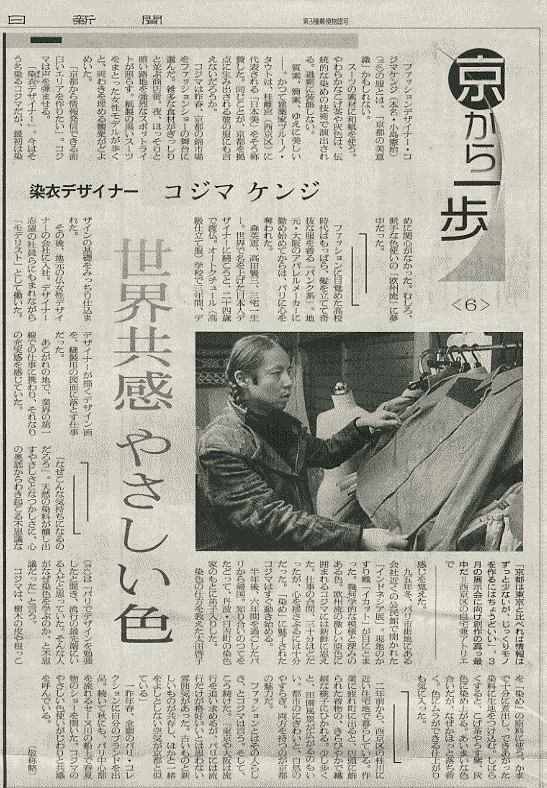ASAHI-SHINBUN
7 JANUARY 2001
Fashion designer, Kenji Kojimafs clothes is regarded as the eAesthetic of Kyotof.
He uses Japanese paper, called eWashif, for the material of his suits. Soft dark brown and gray colors are produced by the technique of a Japanese traditional dye. It is not expressed to be excessively decorative.
Bruno Taut, a German architect, once praised the eJapanese beautyf exemplified by Katsura Imperial Villa (Nishikyo Ward), eSimple and concise, therefore beautifulf. Wouldnft this comment be applied to the dresses he creates who is based in Kyoto?
Last spring, Mr. Kojima chose Nishiki-ichiba, an old market place in Kyoto as the stage of his fashion show. It is a shopping mall where various traditional foods neatly line up during the day. A strong spotlight shines on the slightly dark alley at night. The crowds of spectators on the sides of the stage were wowed as the models walked along with his black paper dresses on.
eI want to make an interesting area where information can be sent out from Kyoto.f, Mr. Kojima says with his voice in the energetic tone.
He calls himself D-y-esigner, but was not interested in dyeing first. He was even crazy about "Europe style" of gaudy coloring.
The trend during his high school days when he woke up to fashion was rather epunk stylef that the hair is up with unique clothes. After he began working for a local apparel maker in Osaka, he was fascinated with Paris.
Hanae Mori, Kenzo Takata, Issey Miyake. With a hope to follow the Japanese designer who won fame in the world, he moves to France at the age of 24. His design foundation was thoroughly trained for three years at the haute couture school in Paris.
Afterwards, he joins the company of the French female designer there. He works as a "Modeliste" among the staffs who hopes to be a designer in the future.
His task was to transfer the design work drawn by the designer to the drawing for needlework.
He engages himself in work in the first line of the fashion industry on the ground of the yearning, and felt a certain level of fulfillment.
"Why do I get this feeling?" One day, he got the mysterious feeling arising from the bottom of his heart by the gentleness and nostalgia that the natural dyestuff creates.
In the winter of 1995, at "Indonesian exhibition" held in public hall near the company in the urban area of Paris, his eyes were caught by eIcatf, the Indonesian local dyeing. The deep colors with geometrical patterns. They seemed fresh to Mr. Kojima who had been surrounded by the intense primary colors of the Europe style. It was only about 30 minutes during his break, but was long enough to impress him. Being enchanted by edyeing e, Mr. Kojima made a quick move.
After 6 months, he comes back from Paris where he spent six years. Through his acquaintances, he became apprenticed to a dye artist in Hiyoshi-cho, Tanba.
Keiko Ota who taught him the method of dyeing says, eAs I heard that he had studied fashion in Paris, I thought he is one of those who are in the frontier of the trend. I felt strange as to why such a person wants to learn dyeing.f
Mr. Kojima uses the bark and the root of tree for the raw material of eDyeingf. They are boiled thoroughly in the big kettle called eKamaf, and the fabric is dipped into it. After a while, the fabric is dyed to dark brown, pale purple, or gray. Although it is a vague shade, it somewhat makes you feel relaxed. When it is finished, the irregularity of the colors is also pleasurable.
He now lives in a residential area near Katsuragawa in Nishikyo Ward from 2 years ago. If he goes out to the city district after the elaborate dyeing work, there are fascinating shiny, yet delicate kimonos displayed in the storesf showcases. Walking a little bit further, it is also good that the pastoral landscape spreads out. Bustle of city and relief of nature in city. It is a charm of Kyoto that there are both sides.
gFashion is to be oneselfh, Mr. Kojima says. gAlthough Tokyo and Osaka go after trend, there was an atmosphere in Paris that not only the trend was fashionable. The atmosphere where both the old and the new coexist and the air that doesnft accept the sameness to others are similar to those in Kyoto.h, he continues.
In the spring the year before last, he exhibited his own work in his long-coveted Paris Collection. He continuously held his spring & summer collection in a shipboard in the Seine river that flows in the center of Paris. Mr. Kojimafs gentle coloring is gradually gaining the compathy.
gAlthough there is much less information in Kyoto if compared with Tokyo, it is good enough to focus on something to be created thoroughly.h He is in the middle of the preparation of his work for March exhibition; at his atelier & home in Nishikyo Ward, Kyoto.
